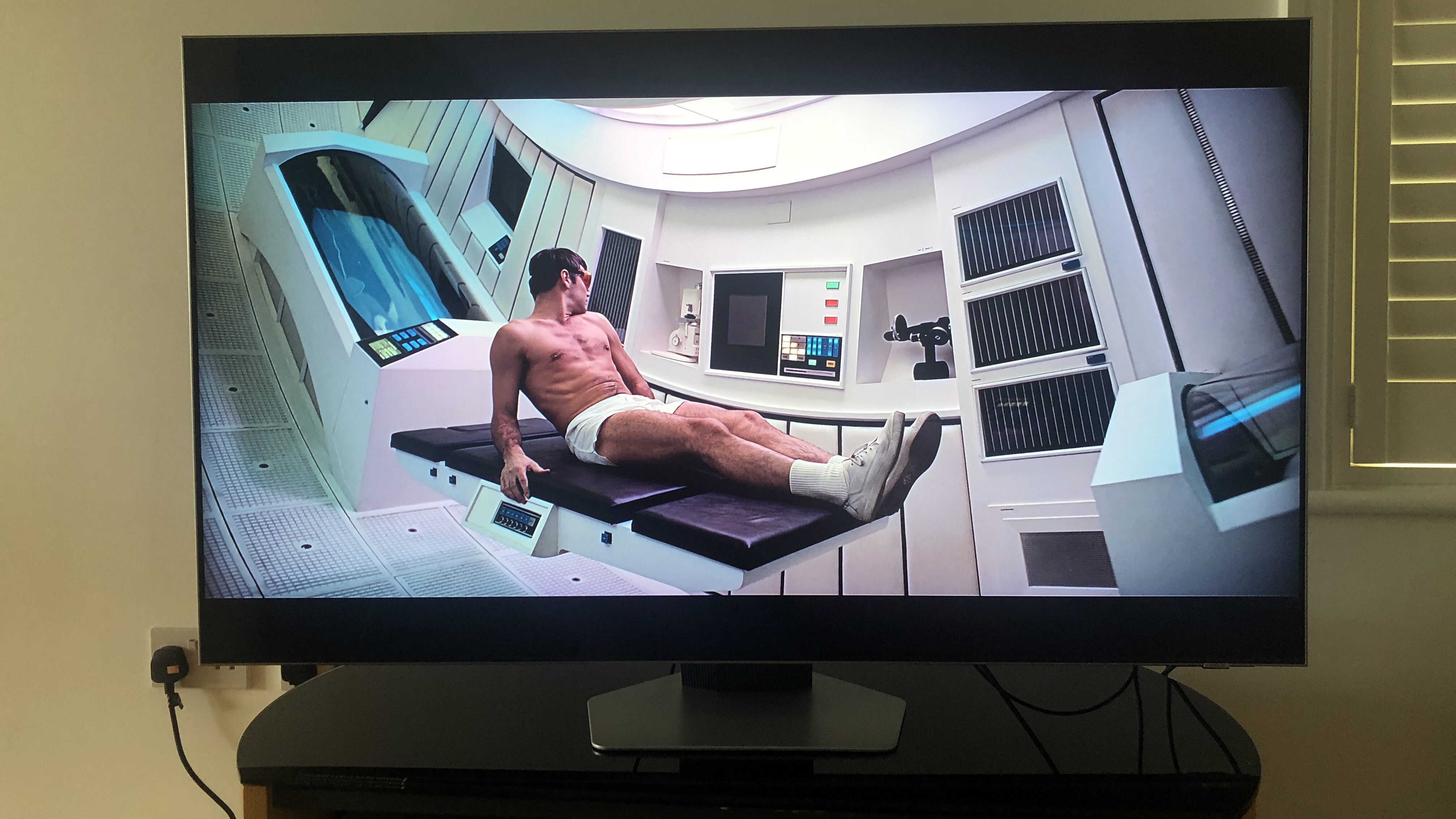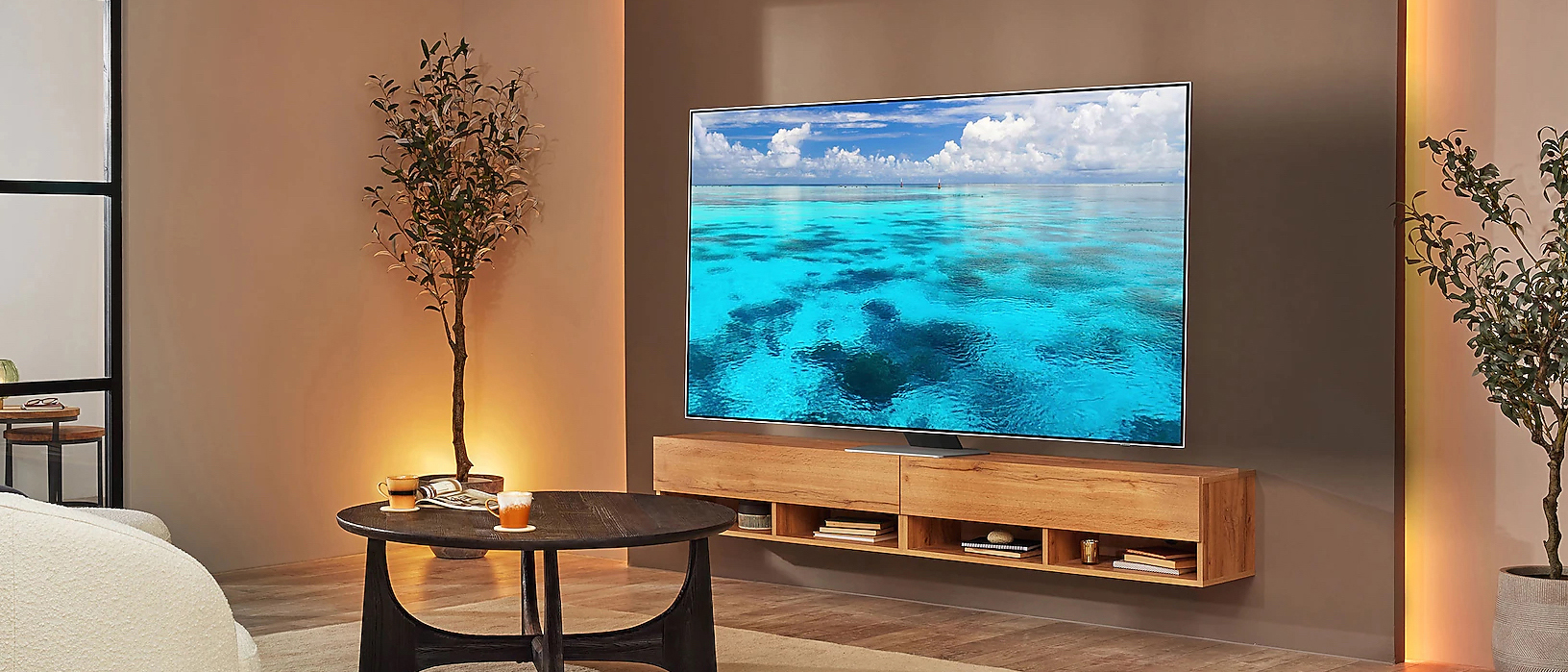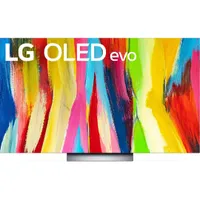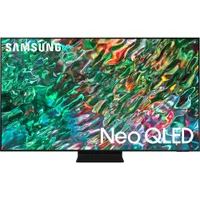TechRadar Verdict
The Samsung QN85B is a brilliantly accomplished TV in so many ways for movies and gaming, but it lacks the across-the-board excellence of its best rivals at the same price, such as the LG C2.
Pros
- +
Slim and elegant design
- +
Bright and lavishly colourful images
- +
Great gaming support
Cons
- -
Struggles to deliver black-tone detail
- -
No Dolby Vision HDR
- -
Smart TV changes are not for the better
Why you can trust TechRadar
Samsung QN85B: two-minute review
The Samsung QN85B looks like an incredibly competitive TV on paper, and while the battle is never won on paper, you have to start somewhere. Its Mini-LED technology (which Samsung calls Neo QLED) is apparent both in the slimness of the screen’s profile and in its high levels of brightness peak brightness.
For gamers, the Samsung QN85B has HDMI 2.1 features across all its HDMI sockets and can exploit every feature of your next-gen console. It’s also fitted with a state-of-the-art picture processor, a redesigned version of the Tizen smart TV interface that’s been a highlight of Samsung TVs for a while now, and it’s got six speaker drivers that want to give you a tiny taste of spatial audio.
And it’s got all of this at a price that looks competitive against high-end TVs among the larger sizes – we tested the 55-inch model, but we also want to pick out the 75-inch version as being among the best 75-inch TV and undercutting the OLED competition on price. (We'll cover the rest of the sizes in a moment.)
On paper, all this is enough to make you overlook Samsung’s usual refusal to include Dolby Vision HDR.
In practice, though, things aren’t so cut and dried. Yes, this is a bright screen – and yes, its contrasts are wide as a result. But despite the numerousness of its backlighting zones, it can’t bring convincing levels of detail to the black tones it generates – and it’s not immune to backlight bloom or smear, either. It simply doesn't match the best OLED TVs for precision.
The new smart TV software is most definitely not improved compared to last year's model – quite the opposite, in fact. And its sound, though quite expansive, is predictably undynamic and short of low-end extension.
The Samsung QN85B is far from bad, and in some ways it’s a bit of a bargain. But there’s no doubt Samsung has left the door open for the likes of the LG C2 to tempt you away for an extremely similar price, with an overall better picture… even if the QN85B does have some advantages of its own.
Sign up for breaking news, reviews, opinion, top tech deals, and more.
Samsung QN85B review: Price and release date
- Released in spring 2022
- Available in 55-inch, 65-inch, 75-inch and 85-inch sizes
- Prices start from £1,399/$1,499/AU$2,499
The Samsung QN85B is on sale now, and it’s available in four different screen sizes. The 55-inch 55QN85B we tested for our review costs £1,399 / $1,499 / AU$2,499, while the 65-inch version is priced at £2,199 / $1,999 / AU$3,299, and the 75-inch version will set you back £3,299 / $2,799 / AU$4,499. Those with an especially large viewing room can bag the 85-inch model for £4,699 / $3,999 / AU$6,299.
Clearly, the bigger the QN85B you want, the more sense it makes to just be American. But no matter where you end up making your purchase, you know there are similarly sized screens from the obvious big-hitters – the LG C2 and Sony A80K in particular - available at similar money. The TV market is about as fiercely contested as they come, which is nothing but good news for consumers.

Samsung QN85B review: Features
The QN85B range is based on Mini-LED technology (or Neo QLED, as Samsung’s marketing department insists). We’ve explained Mini-LED technology here, but for now it’s enough to know the QN85B uses many thousands of tiny LEDs to backlight its quantum-dot LCD panel.
The advantages of this are obvious, in theory anyway. Having such a huge number of small LEDs covering the rear of the pixel panel allows the backlighting array to be divided into hundreds of dimming ‘zones’, all of which are individually controllable. So the backlighting can be very precisely targeted to be bright in some zones and dark in others, which should mean better black levels, more convincing contrasts and better control of those scenes of candlelit darkness and what-have-you. And this arrangement allows the QN85B to be impressively slim in profile, too.
Overall picture quality is governed by Samsung’s Neo Quantum Processor 4K. This processor uses some machine learning in an effort to make content of all types and all resolutions look its best on the 55-inch 4K screen. Naturally a lot of effort is expended in bringing HD or SD content up to size, but the Neo Quantum 4K is also designed to exploit the HDR element of any native 4K stuff it’s dealing with.
As far as HDR is concerned, incidentally, it’s Samsung business as usual here – which, though predictable, is a pity. The QN85B supports HLG, HDR10 and Adaptive HDR10+ – but as usual there’s no sign of Dolby Vision. It’s only the most popular HDR format of them all, Samsung…
All four of the QN85B’s HDMI inputs are at 2.1-standard with eARC, and support 4K 120Hz, VRR and ALLM – which is uncomplicatedly excellent news for next-gen gamers, and makes this unquestionably one of the best gaming TVs around. In addition, there are a couple of USB sockets, a digital optical output, an Ethernet socket and TV tuners. Wireless connectivity runs to Bluetooth 5.2 and dual-band Wi-Fi.
As far as audio is concerned, the QN85B is fitted with six little speaker drivers, powered by an all-in total of 60 watts. Two fire dead-ahead, a couple are angled out to the sides in a drive for greater sonic width, and the last two fire upwards from the rear of the chassis – so not only can the QN85B deal with Dolby Atmos soundtracks, it wants to offer a little suggestion of spatial audio as it does so.
Samsung’s also deployed its ‘Object Tracking Sound’ technology is an effort to have sound follow on-screen action even more closely. And if you use an appropriate Samsung soundbar, not only will an eARC connection take care of the data transfer but Samsung’s ‘Q Symphony’ technology allows the TV’s audio system to join in with, rather than be overridden by, the efforts of the soundbar, for a more expansive sound.
- Features score: 4.5/5

Samsung QN85B review: Picture quality
- Beautifully bright and colorful
- Capable of uniformly deep black tones
- Detail in nuance in darkness is lacking
If it’s brightness you want, you’ve come to the right place. When it’s fresh from the box, ‘searing’ is not too strong a word to describe the QN85B’s image quality.
It’s always possible to have too much of a good thing, of course, as the lividity of the Samsung’s pictures is easily regulated in the set-up menus. In fact, spending a bit of time investigating your set-up options is the wise move, as the QN85B is a more subtle and nuanced picture-maker than its out-of-the-box appearance might suggest.
The impressive brightness levels don’t come at the expense of white-tone detail, though. Gradation and variation is always apparent, and the Samsung is able to distinguish between even the most minor differences in shade and tone.
Despite the (endlessly irritating) lack of Dolby Vision HDR compatibility, native 4K content is vibrant and convincing throughout the color palette. There’s tangible depth to primaries, and seemingly limitless nuance of shade and tone – even when dealing with something like a sports field, which might reasonably be considered to be quite uniform in color. Fine detail retrieval is impressive, and the certainty with which the QN85B describes color saturation is remarkable too.
The Samsung retains all of these positive attributes even when viewed quite radically off-axis, too. It doesn’t have the preposterously wide viewing angles of the Samsung S95B QD-OLED TV, naturally, but nevertheless there’s no need to get into a dispute about who’s getting to sit in the sweet spot. The consistency of the QN85B’s color performance is remarkable.
Black tone performance is not quite so successful. The multitude of dimming zones (there are 720 by all accounts, in a 40 x 18 array) means the zones that are not being illuminated are good and black, but the drive for deeper-than-expected black tones also results in some crushing of detail in darkness. There’s an unwelcome uniformity to the black military clothing during the opening scenes of Christopher Nolan’s Tenet, for example, and this general lack of insight into the darkest areas of the screen never really goes away.
The upside to this is how well the Samsung controls its backlighting, though. Unless you’re watching a black screen with some white text on it, there’s negligible bloom or bleed of white tones – control is generally pretty impressive. Transitions between dimming zones is rapid too, though very small areas of brightness against black backgrounds can get lost entirely in a way that they wouldn't with an OLED TV.
Edge-definition is pretty impressive, the QN85B managing to keep even complicated outlines stable and smooth, and equally good work gets done with tight and/or complicated patterns. Motion-control is a slightly more qualified success – or, more accurately, motion-control is just slightly hit-and-miss unless you switch on ‘LED Clear Motion’ in the set-up menus. For some reason, enabling this setting has an impact on the overall brightness of the Samsung’s images (which is a pity), but the trade-off is most definitely worth it.
The Samsung’s Neo Quantum Processor 4K proves adept at upscaling 1080p content to fit the QN85B’s 4K panel, with some minor and fairly obvious caveats. There are mild-but-appreciable drop-offs where detail retention, edge definition and color balance are concerned, but they’re in no way problematic. It almost goes without saying that the rather unknowable nature of the Samsung’s black tones doesn’t get any better, either. But motion remains composed, and the QN85B is never less than eminently watchable.
No matter what you’re watching, though, the QN85B is distractingly reflective. Samsung has deployed a semi-gloss coating to try and mitigate reflections, but while they’re quite diffuse there’s no unseeing them – especially in the darkest moments. If your TV is facing a white painting or something like that, don’t imagine you won’t be seeing it reflected in your television screen.
A big advantage of the brightness of a Mini-LED TV is to make it more visible than dimmer OLED TVs in light rooms where reflections might be an issue. And overall that's probably the case here, yet the reflectivity is still stronger than we'd hope.
- Picture quality score: 4/5

Samsung QN85B review: Sound quality
You can’t fault Samsung as far as ‘making the effort’ is concerned. The QN85B’s six speaker drivers, along with its Object Tracking Sound technology and Q Symphony compatibility, all point to a TV that’s had more care lavished on its audio performance than is the norm.
Most importantly, the midrange – where the voices exist – sounds clear, believable, and detailed enough to let character and diction apparent. There’s not a great deal of potency or dynamism to the Samsung’s sound, though, which puts it at odds with the vibrancy of its images more than somewhat. There’s a lack of outright power to the QN85B’s sound, too, which puts it at an even greater remove from the picture quality it accompanies.
The Object Tracking Sound arrangement is a low-key success, though, with a little suggestion of sound emanating from particular areas of the screen adding to the unity of the audio/video presentation. It’s a little more successful than the suggestion of ‘spatial’ audio the TV’s driver array is supposed to deliver, which is mild in the extreme.
Unsurprisingly, the QB85B can’t summon much by way of bass presence – and what low-end activity it can muster starts to sound quite stressed at even quite modest volumes.
The sound here is clear enough to mean you'll never struggle to know what's going on, and the OTS system adds some positional dynamism, but what's here won't replace one of the best soundbars for home theater punch.
- Sound quality score: 3/5

Samsung QN85B review: Design
No sensible person wants their nice new television to look anything other than modern, slim and basically all screen – do they? And it’s these ‘sensible people’ Samsung is catering for with the QN85B.
At a mere 27mm / 1.1 inches deep, this 55-inch model is more than slim enough to hang easily on the wall, and at 17.2kg / 38 lbs it’s not too much of a burden where weight is concerned for wall mounting either. The bezels surrounding the screen are minimal when viewed from dead ahead, and are nicely finished in what Samsung is calling ‘bright silver’ when seen in profile.
If you decide against wall-hanging, the TV can instead sit securely on a sturdy, vaguely hexagonal, foot that’s also finished in ‘bright silver’. It has a little rudimentary cable management built in, it elevates the bottom of the screen sufficiently for a soundbar to sit happily beneath, and it adds another three kilos to the overall kerb-weight. There’s no cable management on the rear of the screen itself, though, no click-on plastic panel to hide the numerous connections you’re bound to have made.
As is becoming commonplace these days, the QN85B ships with a couple of remote control handsets. One is a slim, elegant, solar-powered item covering the most common functions, the other is plasticky and has a lot of very small buttons on it. You’re bound to need it at some point, though, so try to remember where you ditched it in favour of its solar-powered partner.
Because Samsung is still pushing its ‘SmartThings’ control app quite hard, and willing you to incorporate your TV into your wider network of (ideally Samsung) connected products, the QN85B is compatible with Alexa and Google Assistant voice-control. It works well, and happily predictably, no matter if your television is a stand-alone item or just one element of your smarter-than-smart home.
- Design score: 4.5/5

Samsung QN85B review: Smart TV and menus
Samsung’s Tizen-based smart TV interface has been among the best around for a good few years now – but despite it being demonstrably not broken, Samsung has gone ahead and tried to fix it anyway.
So now the smart interface covers the entire screen rather than knowing its place (which was a couple of decks at the bottom of the screen). And it uses all the extra space to make recommendations of curated content that takes an awfully long time to catch up with the sort of stuff you might have actually been watching.
It’s not as responsive as it used to be, either, which makes navigating the whole area a less pleasant and more frustrating experience than previously where Samsung TVs are concerned. Still, at least this ‘upgrade’ brings with it Samsung TV Plus, a free selection of hard-to-come-by streamed TV services – which is undeniably a good thing.
Set-up menus are decently extensive but not intimidatingly so. It’s easy to get perfectly serviceable quality for both picture and sound without spending much time or effort, while those who prefer a deep dive into the minutiae have plenty of options.
The ‘smart calibration’ feature in the ‘Picture’ set-up menus allows a sort of quasi-professional level of tweakery using just your smartphone.
- Smart TV and menus score: 3/5

Samsung QN85B review: Gaming
With HDMI 2.1 support across all four HDMI inputs, compatibility with 4K 120Hz and support for ALLM, VRR and FreeSync Premium Pro, the QN85B looks equipped to make the most of a next-gen console. And when you add in the popping brightness, assured motion tracking and mile-wide color palette already discussed, that’s how it proves. Mostly, anyhow.
Not unreasonably, the screen defaults to ‘Game’ mode when it detects the relevant signal. The results in the screen giving you everything it’s got, color-wise, reduces response and input lag times down to impressively low levels indeed, and lets the TV use its remarkable brightness to make the most of the lavish lighting effects apparent in, say, Gran Turismo 7.
But it also results in backlighting seeming less focused and responsive than when watching other input sources. The processor is obviously balancing working its magic without adding delay to the image, and a knock-on effect is the increase in white-tone blooming and the drop-off in zone-by-zone control.
It's a shame you don't get Nvidia G-Sync or Dolby Atmos gaming support here too (though the former is only relevant for PC gamers, and the latter for Xbox Series X gamers).
- Gaming score: 4/5

Samsung QN85B review: Value
It goes without saying that you’re far from short of choice when it comes to picking a premium TV that costs around this sort of money. Our particular favourite remains the LG C2 OLED TV, which has already dropped to similar prices to the QN85A at times with discounts. But there's also the (slightly more expensive) Sony A80K, while UK buyers can find the Philips OLED806 available for very aggressive prices now.
The price/specification/screen-size ratio is pretty aggressive for the QN85B, though, and specifics such as the full-fat nature of all four HDMI inputs are bound to make some consumers’ minds up for them. The slim and relatively elegant nature of the television itself doesn’t do any harm either – and who doesn’t approve of a solar-powered remote control?
Samsung’s taken a backward step with the reworking of its Tizen smart TV interface, mind you, and while OLED-fanciers will be blown away by the sheer raw brightness of the QN85B’s Mini-LED panel they’ll be far less enamored of its rather flat and guarded nature of its black-tone response. And just because we’re all used to Samsung ignoring Dolby Vision HDR, that doesn’t mean we approve of it.
- Value score: 4/5
Should you buy the Samsung QN85B?
| Attributes | Notes | Rating |
|---|---|---|
| Features | Excellent connectivity and great audio tech, but shame about the lack of Dolby Vision. | 4.5/5 |
| Picture quality | Wonderfully bright and colorful, with great detail, but struggles with detail in darkness and reflections. | 4/5 |
| Sound quality | Perfectly clear, with good matching to on-screen action, but it's thin. | 3/5 |
| Design | Impressively thin, with a nice stand and excellent finish. | 4.5/5 |
| Smart TV and menus | The new Tizen is a bit slow and overbearing, but is well-equipped. We like the remotes. | 3/5 |
| Gaming | Four HDMI 2.1 ports with 4K 120Hz and VRR, plus super-low lag make this very well-equipped. | 4/5 |
| Value | Right in line with premium competition for features, but lacking the fully refined image quality of some of them. | 4/5 |
Buy it if…
You’re after a TV brighter than the brightest OLED
As far as straightforward ‘punch’ goes, OLED can’t lay a glove on Mini-LED.
You’ve got game
Full-on HDMI 2.1 smarts on all four HDMI ports, plus low response times and that lovely brightness, make for a great gaming experience.
Don't buy it if…
You want the full nuance of HDR images
With no Dolby Vision for Netflix/Disney+ and limited detail in black areas, its cinematic chops are a bit behind similarly priced OLEDs.
You have issues with patience
The changes Samsung has made to its smart TV interface are not exactly intuitive.
Also consider
LG C2
A 55-inch C2 is now yours for under £1,500 / $1,600 / AU$2,600– and that money buys respectable (if not Samsung-bothering) brightness, balanced and refined overall image quality, and a smart TV interface that doesn’t go out of its way to wind you up.
Samsung QN90B
The next TV up from the QN85B features better reflection handling, more brightness and better handling of dark scenes. Basically, all the QN85B's biggest issues get fixed, for a bit more money.

Simon Lucas is a senior editorial professional with deep experience of print/digital publishing and the consumer electronics landscape. Based in Brighton, Simon worked at TechRadar's sister site What HiFi? for a number of years, as both a features editor and a digital editor, before embarking on a career in freelance consultancy, content creation, and journalism for some of the biggest brands and publications in the world.
With enormous expertise in all things home entertainment, Simon reviews everything from turntables to soundbars for TechRadar, and also likes to dip his toes into longform features and buying guides. His bylines include GQ, The Guardian, Hi-Fi+, Metro, The Observer, Pocket Lint, Shortlist, Stuff T3, Tom's Guide, Trusted Reviews, and more.


